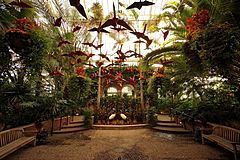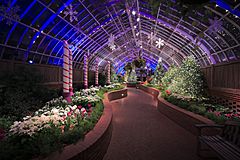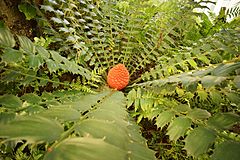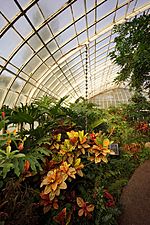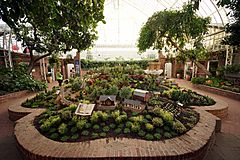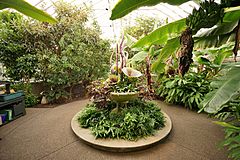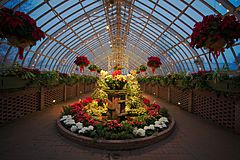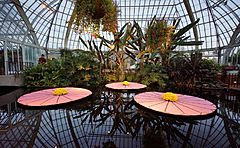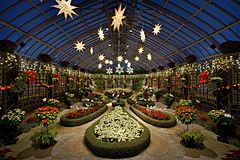Phipps Conservatory and Botanical Gardens facts for kids
|
Phipps Conservatory and Botanical Gardens
|
|
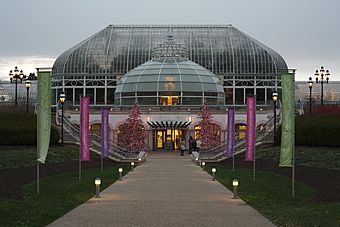
Main entrance to Phipps Conservatory and Botanical Gardens
|
|
| Location | Pittsburgh, Pennsylvania |
|---|---|
| Area | 15 acres |
| Built | 1893 |
| Architect | Lord & Burnham |
| Architectural style | Victorian greenhouse |
| NRHP reference No. | 76001598 |
Quick facts for kids Significant dates |
|
| Added to NRHP | November 13, 1976 |
Phipps Conservatory and Botanical Gardens is a super cool botanical garden located in Schenley Park, Pittsburgh, Pennsylvania, United States. It's like a giant indoor and outdoor museum for plants! This special place is a historic landmark in Pittsburgh and is also listed on the National Register of Historic Places.
A rich man named Henry Phipps gave these gardens as a gift to the City of Pittsburgh in 1893. His goal was to teach and entertain people with beautiful gardens and amazing plants from all over the world. You can find everything from tall palm trees to tiny bonsai and colorful orchids here. The buildings themselves are also special, showing off a cool Victorian style with lots of glass and metal.
Phipps is known for being one of the most "green" places on Earth. Its main entrance building has a special silver-level certification for being environmentally friendly. The greenhouses where they grow plants have an even higher Platinum certification. Plus, the Center for Sustainable Landscapes building is designed to be super eco-friendly. It even makes all its own energy!
Contents
- Discover the History of Phipps Conservatory
- Explore the Indoor Gardens at Phipps
- Palm Court: A Grand Entrance
- Serpentine Room: A Winding Path
- Fern Room: Ancient Plants
- Orchid Room: A Burst of Color
- Stove Room: Home to Butterflies
- South Conservatory: Seasonal Shows
- Tropical Fruit and Spice Room: Taste the Tropics
- Tropical Forest Conservatory: A Rainforest Adventure
- Gallery Room: Fun for Kids
- Sunken Garden: Changing Beauty
- Desert Room: Cacti and Succulents
- Victoria Room: A Central Oasis
- Broderie Room: French Garden Style
- East Room: Streams and Waterfalls
- Explore the Outdoor Gardens at Phipps
- Center for Sustainable Landscapes: Super Green Building
- Images for kids
- See also
Discover the History of Phipps Conservatory
The Phipps Conservatory was started in 1893. It was a gift from Henry Phipps, Jr. to the city of Pittsburgh. The famous architects Lord & Burnham designed the Conservatory. It cost $100,000 to build, which was a huge amount of money back then!
The main glasshouse, which had nine display rooms, was finished in August 1893. This was just one year after they started building it. On December 7, 1893, Phipps Conservatory opened its doors to the public. Many of the first plants came from the big World's Columbian Exposition fair in Chicago.
In 1970, the Conservatory was named a Historic Landmark. This means it's a very important building in Pittsburgh's history. Later, in 1976, it was added to the National Register of Historic Places. This is a list of places important to the history of the whole United States.
For many years, the City of Pittsburgh ran Phipps Conservatory. But in 1993, it became a non-profit organization. This means it's still owned by the city, but a private group manages it. They use any money they make to keep the gardens running and beautiful.
In 2003, Phipps started a big expansion project. They added a new Welcome Center in 2005. This building has a cool dome that looks like something from the Victorian era. They also built new greenhouses and a Tropical Forest Conservatory in 2006.
The Tropical Forest Conservatory changes its theme every three years. It started with a theme about Thailand. This area has waterfalls, bridges, and plants from Thailand. It also teaches visitors about Thai culture. Later, it featured the "Headwaters of the Amazon" theme.
In 2007, Phipps worked with a famous glass artist named Dale Chihuly. He and his team created amazing glass sculptures to display with the plants. It was like art and nature coming together! Phipps loved the art so much that they bought many pieces for their permanent collection. These include a chandelier in the Welcome Center and other sculptures in different rooms.
Another glass artist, Hans Godo Frabel, also had an exhibit at Phipps in 2009. His glass art was more realistic, showing things like glass orchids and lotus plants. This "Gardens and Glass" exhibit was very popular too.
Explore the Indoor Gardens at Phipps
Palm Court: A Grand Entrance
The Palm Court is the first room you see when you enter Phipps. It's designed in a grand Victorian style. This room is filled with many different kinds of palm trees. It also has the original plaque from when the Conservatory first opened. You can see some of the beautiful glass art by Dale Chihuly here too. The ceiling of the Palm Court is very high to make space for the tall palm trees.
Serpentine Room: A Winding Path
The Serpentine Room is next to the Palm Court. Its name comes from its curved, winding pathway. The plants in this room change with the seasons. This means you'll see different flowers and displays depending on when you visit. Plants line both sides of the path and hang from the ceiling.
Fern Room: Ancient Plants
The Fern Room is home to many kinds of ferns. You'll also find cycads here. These plants were very common millions of years ago, even before flowering plants existed. It's like stepping back in time! Some cool plants you might see are the Munch's cycad and the Staghorn fern.
Orchid Room: A Burst of Color
The Orchid Room is full of amazing orchids. Orchids come in so many different colors, shapes, and sizes. You can see tiny orchids and a special collection of Slipper Orchids. There's even a unique orchid named after Frank Sarris, who founded Sarris Candies. This room started with a big gift of 800 rare orchids in 1931.
Stove Room: Home to Butterflies
From spring to fall, the Stove Room becomes the Butterfly Forest! It's filled with many beautiful butterflies flying around. The plants in this room are from warm, tropical places. The room is kept warm and humid, just like a real jungle.
South Conservatory: Seasonal Shows
The South Conservatory hosts amazing seasonal flower shows. During the fall and winter, it turns into the Garden Railroad exhibit. Here, miniature trains chug along tracks that wind through tiny plants and landscapes. It's a really fun display! This room was originally built between 1896 and 1897.
Tropical Fruit and Spice Room: Taste the Tropics
In the Tropical Fruit and Spice Room, you can see plants that grow delicious fruits, nuts, and spices. Imagine seeing bananas, cinnamon, and coffee plants up close! There's also a beautiful purple and green glass sculpture by Dale Chihuly in the middle of the room.
Tropical Forest Conservatory: A Rainforest Adventure
The Tropical Forest Conservatory is the biggest indoor area at Phipps. It feels like a real rainforest! You'll find man-made waterfalls, winding paths, and a pond with fish. This room changes its theme every three years to feature different regions of the world. It's also where many special events and programs happen.
This conservatory is super energy-efficient. It uses "earth tubes" to help cool the air underground. It also has a special fuel cell that makes electricity from natural gas. Computer-controlled shades block too much sunlight and keep the heat in at night. Even parts of the roof can open!
Gallery Room: Fun for Kids
The Gallery Room has cool displays especially for children. There's an imaginary farmer's market where kids can play and learn about healthy foods. This room is a great place for hands-on learning and fun.
Sunken Garden: Changing Beauty
The Sunken Garden is a beautiful room with fountains and hanging plants. The plants here change with the seasons, so it always looks different. This room has had many looks over the years, including a Japanese-style garden and a Charleston-themed garden.
Desert Room: Cacti and Succulents
The Desert Room is home to plants that love dry, hot places, like cacti and other succulent plants. You'll see plants like the tall Joshua tree and the giant saguaro cactus. There's also a golden glass chandelier by Dale Chihuly called Desert Gold Star. This room first opened in 1902.
Victoria Room: A Central Oasis
The Victoria Room is a large, open space with a big pond in the middle. It has an interactive fountain that's fun to watch. This room connects several other parts of the Conservatory.
Broderie Room: French Garden Style
The Broderie Room is designed like the fancy gardens of French castles from a long time ago. Its name means "flowerbed of embroidery" in French. It's a very popular spot for weddings and photos because it's so beautiful. This room opened in 1939.
East Room: Streams and Waterfalls
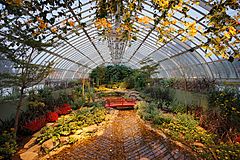
The East Room features gentle streams and small waterfalls. Like many other rooms, its plant displays change with the seasons. It's a peaceful place to enjoy nature's beauty.
Explore the Outdoor Gardens at Phipps
Rooftop Edible Garden: Grow Your Own Food
The Rooftop Edible Garden is a special outdoor space where they grow vegetables and fruits. The fresh produce from this garden is used in the cafeteria at Phipps. It's also a great place for kids to learn about where their food comes from.
Japanese Courtyard Garden: Peaceful Bonsai
The Japanese Courtyard Garden is a calm and beautiful space. It features a traditional Japanese garden design. You can also see several tiny, perfectly shaped bonsai trees here. This garden was designed by Hoichi Kurisu and installed in 1991.
Children's Discovery Garden: Fun for All Ages
The Children's Discovery Garden is made to attract birds, butterflies, and bees. It has different areas like a bog garden and a sensory garden. These outdoor spaces are designed to entertain and teach children about nature in a fun way.
Outdoor Garden: A Variety of Plants
The Outdoor Garden is a large area with many smaller gardens. You can find an herb garden, a medicinal garden, and collections of ferns and small trees here. The paths in this garden were built way back in 1935!
Botany Hall: Learning About Plants
The Botany Hall has a small garden with benches and a fountain. Henry Phipps funded this hall in 1901. It was meant for teachers to use when bringing their classes to the Conservatory. Today, it's still used for many educational programs and events.
Aquatic Garden: Water Plants and Statues
The Aquatic Garden has two pools filled with tropical water plants. In the summer, you can see beautiful floating flowers. One of the pools has a statue of Neptune, the Roman god of the sea. This statue was given to Phipps shortly after it opened in 1893.
Center for Sustainable Landscapes: Super Green Building
The Center for Sustainable Landscapes (CSL) is a building at Phipps that is designed to be incredibly good for the environment. It opened in December 2012. This building actually makes all of its own energy! It also cleans and reuses all the water that falls on its property. Inside, you'll find signs, interactive screens, and art that teach you about sustainability. There's even a classroom for kids.
The CSL has received a special Platinum LEED certification. It also meets the tough standards of the Living Building Challenge for being a net-zero energy building. This means it produces as much energy as it uses. Plus, it's the first and only building to get Four Stars from the Sustainable SITES Initiative for its landscaping. All these awards make the CSL one of the "greenest" buildings in the entire world!
Images for kids
See also
 In Spanish: Phipps Conservatory & Botanical Gardens para niños
In Spanish: Phipps Conservatory & Botanical Gardens para niños




